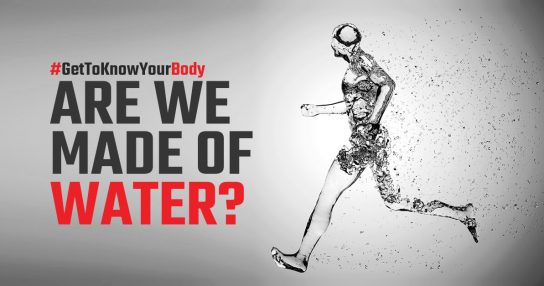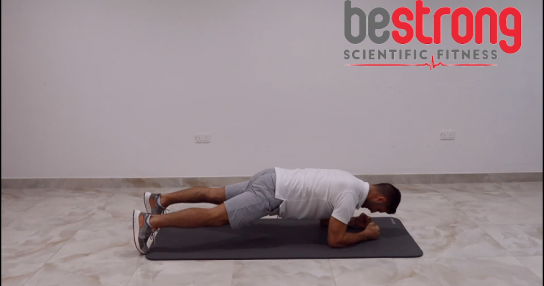Are we? Questions it is not spiritual. It is based on facts that we cannot deny.
The amount of water in the human body ranges from 45-75%. The average adult human body is 50-65% water, averaging around 57-60%. The percentage of water in infants is much higher, typically about 75-78% water, dropping to 65% by one year of age.
Body composition varies according to gender and fitness level because fatty tissue contains less water than lean tissue. The average adult male is about 60% water. The average adult woman is about 55% water because women naturally have more fatty tissue than men. Overweight men and women have less water, as a percent than their leaner counterparts.
The percent of water depends on your hydration level. People feel thirsty when they have already lost around 2-3% of their body’s moisture. Being dehydrated by just 2% impairs performance in mental tasks and physical coordination. The amount of water varies, depending on the organ. Much of the water is in blood plasma (20% of the body’s total). According to a study published in 1945 and still widely cited, the amount of water in the human heart and brain is 73%, the lungs are 83%, muscles and kidneys are 79%, the skin is 64%, and the bones are around 31%.
Water serves multiple purposes:
- Water is the primary building block of cells.
- It acts as an insulator, regulating internal body temperature. This is partly because water has a high specific heat, plus the body uses perspiration and respiration to regulate temperature
- Water is needed to metabolize proteins and carbohydrates used as food. It is the primary component of saliva, used to digest carbohydrates and aid in swallowing food.
- The compound lubricates joints.
- Water insulates the brain, spinal cord, organs, and fetus. It acts as a shock absorber.
- Water is used for flushing waste and toxins from the body via urine.
- Water is the principal solvent in the body. It dissolves minerals, soluble vitamins, and certain nutrients.
- Water carries oxygen and nutrients to cells.
If the body is not hydrated enough – it naturally will run to a condition called dehydration.
Dehydration happens when your body doesn’t have as much water as it needs. Without enough, your body can’t function properly. You can have mild, moderate, or severe. Dehydration depending on how much fluid is missing from your body. Dehydration symptoms generally become noticeable after 2% of one’s average water volume has been lost. You can usually reverse mild to moderate dehydration by drinking more fluids, but severe dehydration needs immediate medical treatment. There are three main types of dehydration: hypotonic (primarily a loss of electrolytes), hypertonic (primarily loss of water), and isotonic (equal loss of water and electrolytes). The most commonly seen in humans is isotonic.
Symptoms of mild dehydration are fatigue, dry mouth, increased thirst, decreased urination, dry skin, constipation, dizziness, and headache. Severe dehydration symptoms are excessive thirst, lack of sweat production, low blood pressure, rapid heart rate, and breathing; sunken eyes, shriveled skin, and dark urine. Severe dehydration is a medical emergency.
Whole-body sweat rate during exercise ranges from 0.5 to 2.0 L hour−1, with some athletes (~2%) sweating substantially more (>3.0 L hour−1). Gradual reductions in body mass of 2%–5% can occur if body water losses are not replenished, resulting in marked decrements in plasma (≥10%) and blood (≥6%) volume.
Such dehydration levels lead to a state of hyperosmotic hypovolaemia that is proportional to the decrement in total body water. Hyperosmolality during exercise reduces sweat rate, and thus evaporative heat loss, for any given core temperature. As a result, the magnitude of hyperthermia experienced during endurance exercise under heat stress is exacerbated.
Proper hydration has immeasurable benefits for both your health and productivity. Our brain is roughly 75 percent water, so drinking enough fluid is critical for you to remain clear-headed, focused, and creative. Water also delivers essential nutrients to the brain and removes toxins from the blood. Hence, when you’re hydrated, you feel alert and able to concentrate. Water flushes toxins and other unwanted substances out of the body, meaning that there are fewer contaminants in your system if you are hydrated. This improves your complexion with those who drink plenty of fluids as part of their regular diet showing the best skin health and the fewest signs of aging. Hence you’re hydrated, your body maintains optimum blood pressure, which helps your heart pump oxygen around your body. You feel energized, ready to tackle the day’s challenges.
Standard advice recommends the 8×8 rule – that’s eight, eight-ounce glasses of water per day.
Hydration and exercise are very related in both directions, positive if applying hydration rules and negative if we avoid them. Here you can find few tips:
- Before training, drink 12-20oz of fluid 2 hours leading up to exercise.
During Exercise:
- <1-hour drink 16-30 oz of water
- 1-3 hours drink 16-30 oz 6-8% CHO, sodium drink per hour of exercise
- 3 hours similar to guidelines for 1-3 hours but increase sodium intake
- Avoid caffeine or alcohol in beverages due to their diuretic effects.
- Avoid hyponatremia, which can occur by drinking too much fluid, therefore, diluting sodium.
- Monitor dehydration with changes in body weight and urine color. For each pound lost during exercise, drink 15-16oz of fluid.
General hydration tips and alternatives:
- The average person should be consuming around 2.5 liters for men and 2 liters for women per day.
- Sports drinks can re-hydrate the body by providing these lost electrolytes, unlike water, but are mostly recommended to populations like athletes or advanced fitness enthusiasts.
- Products such as fruit and vegetables can be used as a reliable source of both water and electrolytes.
- Alkaline water has a higher pH level than regular drinking water, and because of this, some advocates of alkaline water believe it can neutralize the acid in your body.
- Coconut water has fewer calories, less sodium, and more potassium than a sports drink, low in calories, and naturally free of fat and cholesterol.
- Sassy water is a very useful hydration drink consisting of about 8 1/2 cups of water mixed with one teaspoon of grated, fresh ginger root, cucumber, lemon slices, and fresh mint leaves.
The facts mentioned above are giving us an answer to the question – are we made of water? The answer is YES and NO.
Ivan Cirkovic
Head Coach in Be Strong – Scientific Fitness
02.02.2021.









